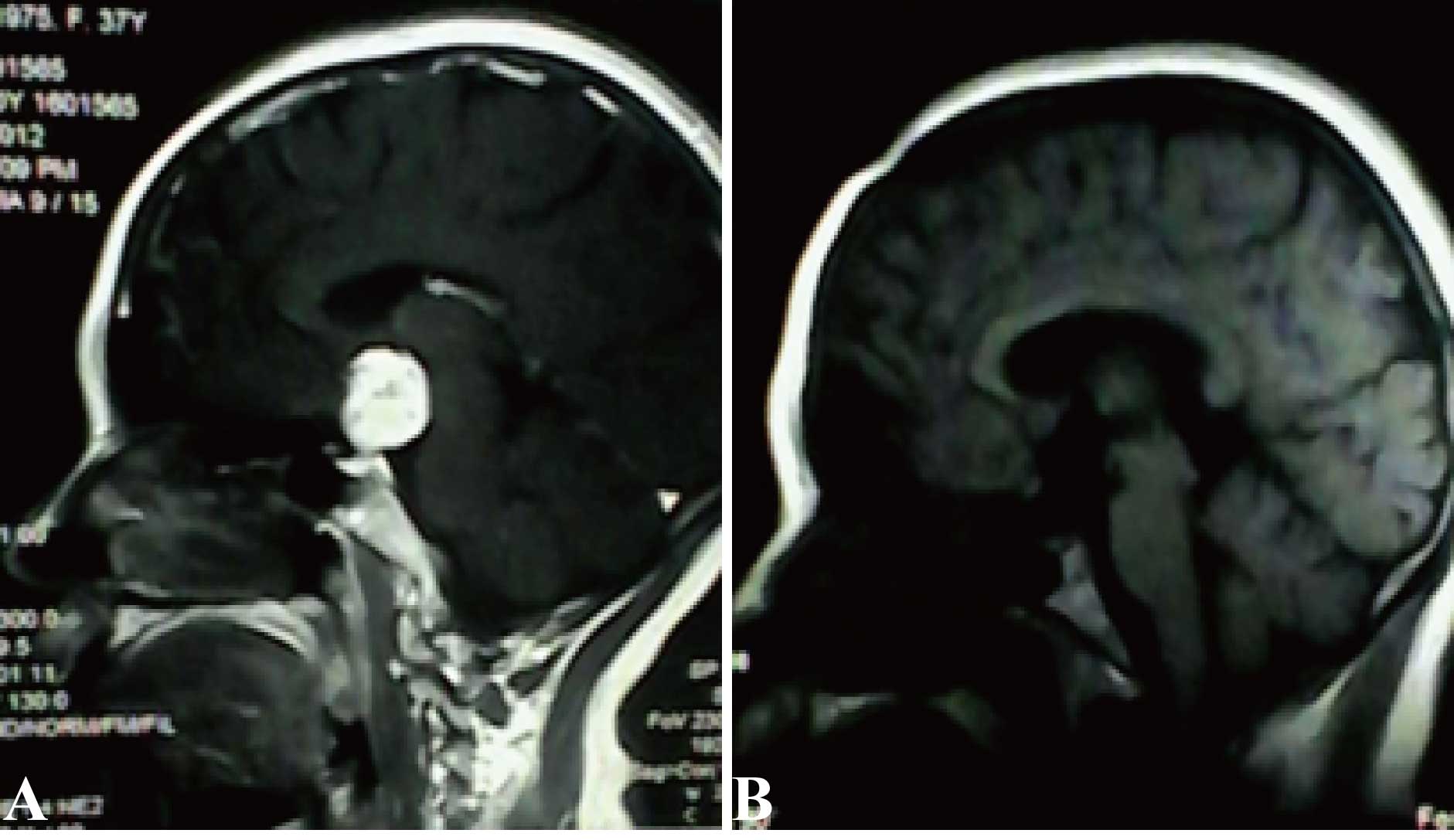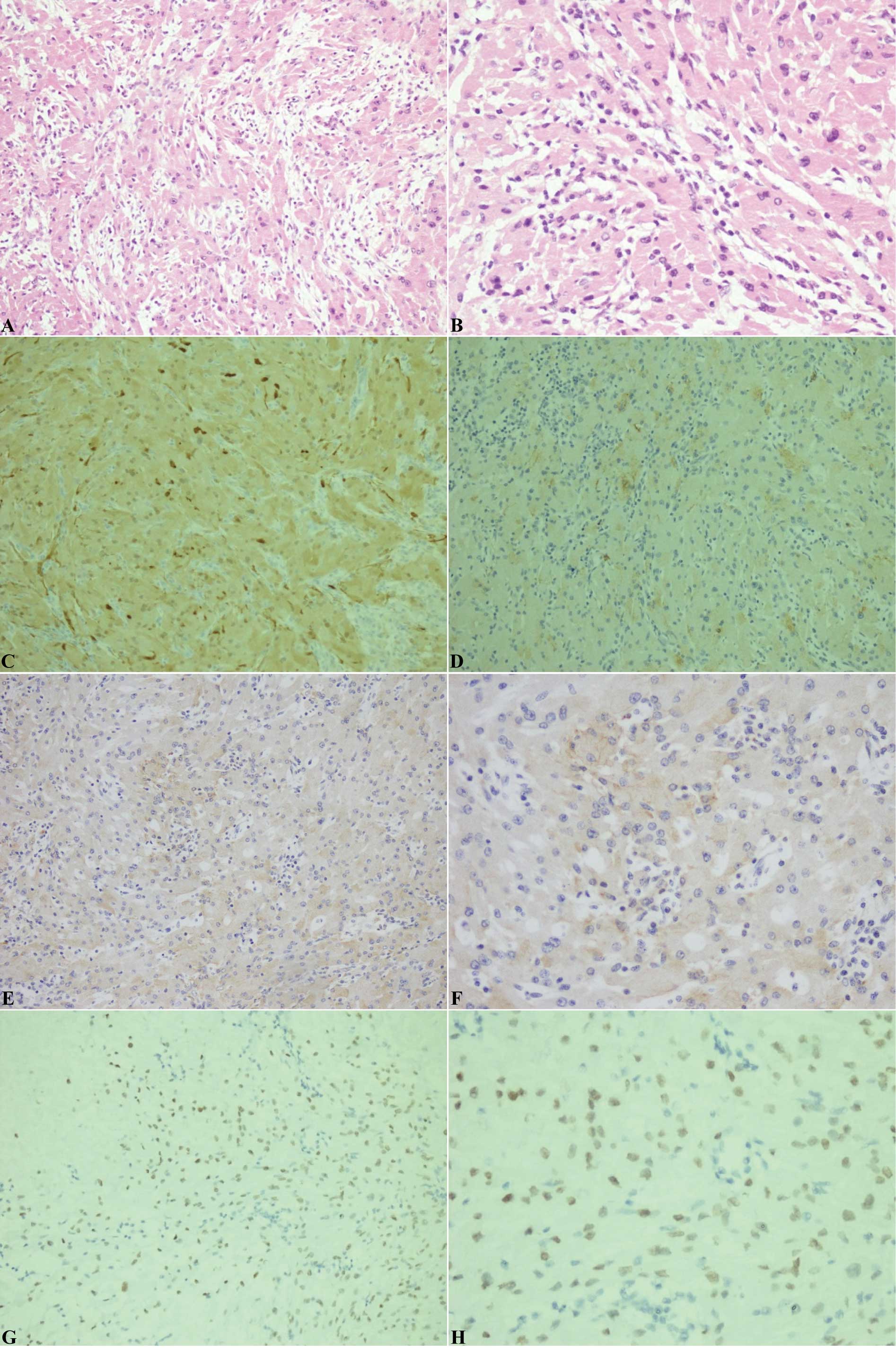|
1
|
Roncaroli F, Scheithauer BW, Cenacchi G,
et al: ‘Spindle cell oncocytoma’ of the adenohypophysis: A tumor of
folliculostellate cells? Am J Surg Pathol. 26:1048–1055. 2002.
View Article : Google Scholar : PubMed/NCBI
|
|
2
|
Matyja E, Maksymowicz M, Grajkowska W,
Olszewski W, Zieliński G and Bonicki W: Spindle cell oncocytoma of
the adenohypophysis - a clinicopathological and ultrastructural
study of two cases. Folia Neuropathol. 48:175–184. 2010.PubMed/NCBI
|
|
3
|
Fuller GN: The WHO classification of
tumours of the central nervous system, 4th edition. Arch Pathol Lab
Med. 132:9062008.PubMed/NCBI
|
|
4
|
Kloub O, Perry A, Tu PH, Lipper M and
Lopes MBS: Spindle cell oncocytoma of the adenohypophysis: report
of two recurrent cases. Am J Surg Pathol. 29:247–253. 2005.
View Article : Google Scholar : PubMed/NCBI
|
|
5
|
Coire CI, Horvath E, Smyth HS and Kovacs
K: Rapidly recurring folliculostellate cell tumor of the
adenohypophysis with the morphology of a spindle cell oncocytoma:
case report with electron microscopic studies. Clin Neuropathol.
28:303–308. 2009. View
Article : Google Scholar : PubMed/NCBI
|
|
6
|
Borota OC, Scheithauer BW, Fougner SL,
Hald JK, Ramm-Pettersen J and Bollerslev J: Spindle cell oncocytoma
of the adenohypophysis: report of a case with marked cellular
atypia and recurrence despite adjuvant treatment. Clin Neuropathol.
28:91–95. 2009. View
Article : Google Scholar : PubMed/NCBI
|
|
7
|
Ogiwara H, Dubner S, Shafizadeh S, Raizer
J and Chandler JP: Spindle cell oncocytoma of the pituitary and
pituicytoma: Two tumors mimicking pituitary adenoma. Surg Neurol
Int. 2:1162011. View Article : Google Scholar : PubMed/NCBI
|
|
8
|
Demssie YN, Joseph J, Dawson T, Roberts G,
de Carpentier J and Howell S: Recurrent spindle cell oncocytoma of
the pituitary, a case report and review of literature. Pituitary.
14:367–370. 2011. View Article : Google Scholar
|
|
9
|
Dahiya S, Sarkar C, Hedley-Whyte ET, et
al: Spindle cell oncocytoma of the adenohypophysis: report of two
cases. Acta Neuropathol. 110:97–99. 2005. View Article : Google Scholar : PubMed/NCBI
|
|
10
|
Romero-Rojas AE, Melo-Uribe MA,
Barajas-Solano PA, Chinchilla-Olaya SI, Escobar LI and
Hernandez-Walteros DM: Spindle cell oncocytoma of the
adenohypophysis. Brain Tumor Pathol. 28:359–364. 2011. View Article : Google Scholar : PubMed/NCBI
|
|
11
|
Alexandrescu S, Brown RE, Tandon N and
Bhattacharjee MB: Neuron precursor features of spindle cell
oncocytoma of adeno-hypophysis. Ann Clin Lab Sci. 42:123–129.
2012.PubMed/NCBI
|
|
12
|
Vajtai I, Sahli R and Kappeler A: Spindle
cell oncocytoma of the adenohypophysis: Report of a case with a
16-year follow-up. Pathol Res Pract. 202:745–750. 2006. View Article : Google Scholar : PubMed/NCBI
|
|
13
|
Borges MT, Lillehei KO and
Kleinschmidt-DeMasters BK: Spindle cell oncocytoma with late
recurrence and unique neuro-imaging characteristics due to
recurrent subclinical intratumoral bleeding. J Neurooncol.
101:145–154. 2011. View Article : Google Scholar
|
|
14
|
Mlika M, Azouz H, Chelly I, et al: Spindle
cell oncocytoma of the adenohypophysis in a woman: a case report
and review of the literature. J Med Case Rep. 5:642011. View Article : Google Scholar : PubMed/NCBI
|
|
15
|
Fujisawa H, Tohma Y, Muramatsu N, Kida S,
Kaizaki Y and Tamamura H: Spindle cell oncocytoma of the
adenohypophysis with marked hypervascularity. Case report. Neurol
Med Chir (Tokyo). 52:594–598. 2012. View Article : Google Scholar
|
|
16
|
Singh G, Agarwal S, Sharma MC, et al:
Spindle cell onco-cytoma of the adenohypophysis: Report of a rare
case and review of literature. Clin Neurol Neurosurg. 114:267–271.
2012. View Article : Google Scholar
|
|
17
|
Farooq MU, Bhatt A and Chang HT: Teaching
neuroimage: spindle cell oncocytoma of the pituitary gland.
Neurology. 71:e32008. View Article : Google Scholar : PubMed/NCBI
|
|
18
|
Vajtai I, Beck J, Kappeler A and Hewer E:
Spindle cell oncocytoma of the pituitary gland with follicle-like
component: organotypic differentiation to support its origin from
folliculo-stellate cells. Acta Neuropathol. 122:253–258. 2011.
View Article : Google Scholar : PubMed/NCBI
|
|
19
|
Roncaroli F and Scheithauer BW: Papillary
tumor of the pineal region and spindle cell oncocytoma of the
pituitary: New tumor entities in the 2007 WHO classification. Brain
Pathol. 17:314–318. 2007. View Article : Google Scholar : PubMed/NCBI
|
|
20
|
Covington MF, Chin SS and Osborn AG:
Pituicytoma, spindle cell oncocytoma, and granular cell tumor:
clarification and meta-analysis of the world literature since 1893.
AJNR Am J Neuroradiol. 32:2067–2072. 2011. View Article : Google Scholar : PubMed/NCBI
|
|
21
|
Devnath S and Inoue K: An insight to
pituitary folliculo-stellate cells. J Neuroendocrinol. 20:687–691.
2008. View Article : Google Scholar : PubMed/NCBI
|
|
22
|
Hori S, Hayashi N, Fukuoka J, et al:
Folliculostellate cell tumor in pituitary gland. Neuropathology.
29:78–80. 2009. View Article : Google Scholar
|
|
23
|
Horvath E and Kovacs K: Folliculo-stellate
cells of the human pituitary: a type of adult stem cell?
Ultrastruct Pathol. 26:219–228. 2002. View Article : Google Scholar : PubMed/NCBI
|
|
24
|
Inoue K, Mogi C, Ogawa S, Tomida M and
Miyai S: Are folliculo-stellate cells in the anterior pituitary
gland supportive cells or organ-specific stem cells? Arch Physiol
Biochem. 110:50–53. 2002. View Article : Google Scholar : PubMed/NCBI
|
|
25
|
Lee EB, Tihan T, Scheithauer BW, Zhang PJ
and Gonatas NK: Thyroid transcription factor 1 expression in sellar
tumors: a histogenetic marker? J Neuropathol Exp Neurol.
68:482–488. 2009. View Article : Google Scholar : PubMed/NCBI
|
|
26
|
Mete O, Lopes MB and Asa SL: Spindle cell
oncocytomas and granular cell tumors of the pituitary are variants
of pituicytoma. Am J Surg Pathol. 37:1694–1699. 2013. View Article : Google Scholar : PubMed/NCBI
|













